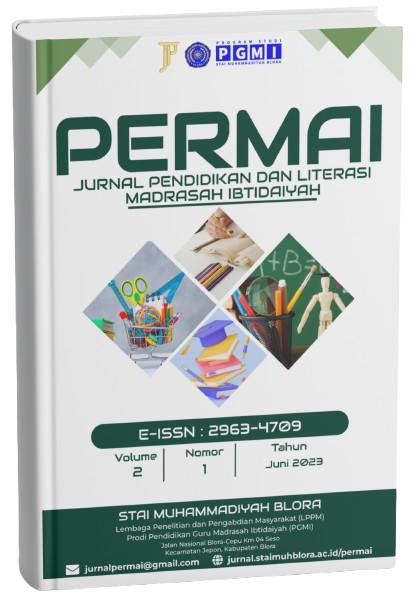IMPLEMENTASI TEORI TAKSONOMI BLOOM PADA MATEMATIKA KELAS 2 SD MUHAMMADIYAH 4
DOI:
https://doi.org/10.63889/permai.v2i1.169Abstract
This study discusses about implementation of Bloom's Taxonomy in mathematics. This is intended to answer the problem how to implement this concept to student with three way, they are planning, implementing and evaluating. This research at SD Muhammadiyah 4 Surakarta Central Java Indonesia in the second grade with 2 teachers. This research uses a qualitative research approach. Technique data collection by interviews. The results showed that the teacher had determine 3 aspects of Bloom's Taxonomy, there is cognitive, affective, and psychomotor aspects. The implementation stage, the teacher applied the cognitive aspects at the level knowledge, understanding, application and evaluation. Affective aspects are seen at the level of acceptance, participants, the formation of life patterns, psychomotor aspects are seen at the level of complex movements, and ordinary movements. In the process of evaluating mathematic learning the teacher also applies Bloom's Taxonomy to the cognitive aspects of the knowledge level. Affective aspects at the level of acceptance, participation, and the formation of patterns of life, aspects of students psychomotor at the level of complex movements.
Keywords: Mathematic Learning Approach, Bloom Taxonomy, Primary School
References
Andriani, R., & Rasto, R. (2019). Motivasi belajar sebagai determinan hasil belajar siswa. Jurnal Pendidikan Manajemen Perkantoran, 4(1), 80. https://doi.org/10.17509/jpm.v4i1.14958
Dahlia, D. (2022). Penerapan Model Pembelajaran Problem Based Learning untuk Meningkatkan Hasil Berlajar Matematika Topik Bilangan Cacah. Pedagogia: Jurnal Ilmiah Pendidikan, 14(2), 59–64. https://doi.org/10.55215/pedagogia.v14i2.6611
Permatasari, K. G. (2023). Penerapan Profil Pelajar Pancasila dalam Pembelajaran Kurikulum Merdeka Pada MI / SD. 8, 169–183. https://doi.org/10.32505/azkiya.v
Juli Loisiana Butar butar, M. A. B. S. (2004). Taksonomi Bloom dan Fungsi Kognitif Carl Jung dalam Pembelajaran matematika. 1, 1–14.
Karaali, G. (2015). Metacognition in the Classroom: Motivation and Self-Awareness of Mathematics Learners. Primus, 25(5), 439–452. https://doi.org/10.1080/10511970.2015.1027837
Kurniawan, A., & Astuti, A. P. (2017). Deskripsi Kompetensi Pedagogik guru dan Calon Guru Kimia SMA Muhammadiyah 1 Semarang. Seminar Nasional Pendidikan, Sains Dan Teknologi, 1–7.
Magdalena, I., Fajriyati Islami, N., Rasid, E. A., & Diasty, N. T. (2020). Tiga Ranah Taksonomi Bloom Dalam Pendidikan. EDISI : Jurnal Edukasi Dan Sains, 2(1), 132–139.
Mulyati, T. (2016). Kemampuan Pemecahan Masalah Matematis Siswa Sekolah Dasar (Mathematical Problem Solving Ability of Elementary School Students). EDUHUMANIORA: Jurnal Pendidikan Dasar, 3(2), 1–20.
Negeri, S. D., & Kanan, K. (2020). Jurnal PAJAR ( Pendidikan dan Pengajaran ) Volume 4 Nomor 1 Januari 2020 | ISSN Cetak : 2580 - 8435 | ISSN Online : 2614 - 1337 DOI : http://dx.doi.org/10.33578/pjr.v4i1.7928 IMPLEMENTATION OF DEMONSTRATION METHOD TO IMPROVE TEACHER Jurnal PAJAR ( Pendidi. 4, 207–218.
Putri, D. N. P., & Arifin, M. B. U. B. (2022). Peran Kinerja Guru Dalam Membentuk Karakter Kerjasama Pada Siswa Kelas IV. Al-Mada: Jurnal Agama, Sosial, Dan Budaya, 5(2), 176–189. https://doi.org/10.31538/almada.v5i2.2517
Wardah, E. Y. (2019). Peranan Guru Pembimbing Khusus Lulusan Non-Pendidikan Luar Biasa (Plb) Terhadap Pelayanan Anak Berkebutuhan Khusus Di Sekolah Inklusi Kabupaten Lumajang. JPI (Jurnal Pendidikan Inklusi), 2(2), 93. https://doi.org/10.26740/inklusi.v2n2.p93-108




.jpg)

